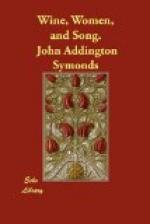IV.
We have reason to conjecture that the Romans, even during the classical period of their literature, used accentual rhythms for popular poetry, while quantitative metres formed upon Greek models were the artificial modes employed by cultivated writers. However this may be, there is no doubt that, together with the decline of antique civilisation, accent and rhythm began to displace quantity and metre in Latin versification. Quantitative measures, like the Sapphic and Hexameter, were composed accentually. The services and music of the Church introduced new systems of prosody. Rhymes, both single and double, were added to the verse; and the extraordinary flexibility of medieval Latin—that sonorous instrument of varied rhetoric used by Augustine in the prose of the Confessions, and gifted with poetic inspiration in such hymns as the Dies Irae or the Stabat Mater—rendered this new vehicle of literary utterance adequate to all the tasks imposed on it by piety and metaphysic. The language of the Confessions and the Dies Irae is not, in fact, a decadent form of Cicero’s prose or Virgil’s verse, but a development of the Roman speech in accordance with the new conditions introduced by Christianity. It remained comparatively sterile in the department of prose composition, but it attained to high qualities of art in the verse and rhythms of men like Thomas of Celano, Thomas of Aquino, Adam of St. Victor, Bernard of Morlais, and Bernard of Clairvaux. At the same time, classical Latin literature continued to be languidly studied in the cloisters and the schools of grammar. The metres of the ancients were practised with uncouth and patient assiduity, strenuous efforts being made to keep alive an art which was no longer rightly understood. Rhyme invaded the hexameter, and the best verses of the medieval period in that measure were leonine.
The hymns of the Church and the secular songs composed for music in this base Latin took a great variety of rhythmic forms. It is clear that vocal melody controlled their movement; and one fixed element in all these compositions was rhyme—rhyme often intricate and complex beyond hope of imitation in our language. Elision came to be disregarded; and even the accentual values, which may at first have formed a substitute for quantity, yielded to musical notation. The epithet of popular belongs to these songs in a very real sense, since they were intended for the people’s use, and sprang from popular emotion. Poems of this class were technically known as moduli—a name which points significantly to the importance of music in their structure. Imitations of Ovid’s elegiacs or of Virgil’s hexameters obtained the name of versus. Thus Walter of Lille, the author of a regular epic poem on Alexander, one of the best medieval writers of versus, celebrates his skill in the other department of popular poetry thus—




